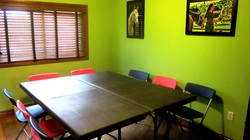Classroom Presentations
 'Home room' for Horse Behaviour and Horse Nutrition classes in Glencairn, ON
'Home room' for Horse Behaviour and Horse Nutrition classes in Glencairn, ON
Classroom Presentations are held in the 'home room' (in Glencairn, ON, 20 min. West of Barrie) or 'on location' and are organized by LoFoSo™ Equine Behaviour. The subjects are taught by means of PowerPoint presentations and include a course binder. Paper, pens, etc. are provided, as well as refreshments (coffee, tea, water and iced tea on hot days) and a light snack.Lunch is provided for 'home room' classes of 5 hours, but on location participants will have to bring their own lunch. Limited spots available per date (max. 8 participants for home room, max. participants on location may vary), online signup will secure your spot. Signup will be closed when courses are full and the web site will be updated. All courses are developed by LoFoSo™ Equine Behaviour and your qualified instructor is Mila Bon, who earned her Equine Studies Diploma (with distinction!) from the University of Guelph (Click Here for more information on Mila's equine education besides the Equine Studies Diploma). New courses will be added as their development has been completed. For course descriptions please see below.
Pricing:
|
In-house - 2 hours, (refreshments & snack included) per person
In-house - 2 1/2 - 3 hours, (refreshments & snack included) per person - Learning Theory Course only! In-house - 5 hours, (1hr lunch & refreshments & snack provided and included) per person - Typically 2 courses On location - 2 hours, (refreshments & snack included) per person On location - 2 1/2 - 3 hours, (refreshments & snack included) per person - Learning Theory Course only! On location - 4 1/2 hours, (1/2 hr. lunch break, bring own lunch, refreshments & snack included) per person - 2 courses |
$30 +HST
$35 +HST $50 +HST $40 +HST $45 + HST $60 +HST Prices subject to change. |
Course Descriptions
INTRODUCTION TO EQUINE BEHAVIOUR
EQUINE LEARNING THEORY
POSITIVE AND NEGATIVE REINFORCEMENT
INTRODUCTION TO CLICKER TRAINING
HORSE NUTRITION BASICS
HORSE NUTRITION: RATION BALANCING
CONDITIONING OF THE HORSE
NEW TO HORSE OWNERSHIP
- Wild horse behaviour / Innate behaviour
- Digestive behaviour
- Locomotive behaviour
- Social behaviour
- Perception: Vision, Smell, Taste, Hearing, Touch
- Mare-foal behaviour
EQUINE LEARNING THEORY
- Different ways a horse learns (with reference to Ethology)
- Habituation and Sensitization
- Counterconditioning
- Positive and Negative reinforcement (how do they work and WHY do they work that way?)
- Exact timing of reinforcements (the 3 second window of opportunity)
- Shaping and Extinction of behaviour
- Optimal learning environment
- Training principles
POSITIVE AND NEGATIVE REINFORCEMENT
- What is positive reinforcement
- How does positive reinforcement work
- Why does positive reinforcement work
- When does positive reinforcement not work
- What is negative reinforcement
- How does negative reinforcement work
- Why does negative reinforcement work
- When does negative reinforcement not work
- Combining positive and negative reinforcement
- Shaping and extinction of behaviour
INTRODUCTION TO CLICKER TRAINING
- What is clicker training
- How does it work
- Primary and secondary reinforcement
- Importance of tone of voice and body language
- Choosing the best reward system for the horse
- Familiarize the horse with the clicker
- The training environment
- The break down into simple steps the horse can understand
- The importance of exact timing
- Shaping and extinction of learned behaviour
- Using the clicker while in the saddle
HORSE NUTRITION BASICS
- The digestive system of the horse
- Water and electrolytes
- Proteins, carbohydrates, fats and fatty acids
- Vitamins and Minerals
HORSE NUTRITION: RATION BALANCING
- Body condition scoring
- Estimating weight
- Estimating energy expenditure
- Estimating weight loss / weight gain
- Balancing rations
CONDITIONING OF THE HORSE
- What is conditioning
- Time schedule for different systems to improve (based on recent research!)
- Important facts about conditioning
- Performing a baseline foundation fitness test
- Cooling down, recovery time, electrolytes, fluid balance and proper nutrition
- Monitoring performance and minimizing risk
- Recognizing behavioural indicators and early warning signs
- How to train for endurance
- How to train for strength
- Designing a training schedule
NEW TO HORSE OWNERSHIP
- What does it take to own a horse (cost, time commitment and challenges at home or boarding facility)
- Horse Care (Locomotion, Forage, Socialization, Introduction to Nutrition Basics, Shelter, Safety & Sense of belonging)
- Basic horse facts (estimating weight, how much water, how much feed, type of hay, vet, farrier etc. etc.)
- How to prevent common diseases
- How to prevent Stereotypies (Vices)